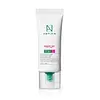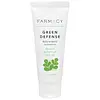What's inside
What's inside
 Key Ingredients
Key Ingredients

 Benefits
Benefits

 Concerns
Concerns

 Ingredients Side-by-side
Ingredients Side-by-side

Water
Skin ConditioningC12-15 Alkyl Benzoate
AntimicrobialTitanium Dioxide
Cosmetic ColorantButylene Glycol
HumectantButyloctyl Salicylate
Skin ConditioningPolymethylsilsesquioxane
Glycerin
HumectantCaprylyl Methicone
Skin Conditioning1,2-Hexanediol
Skin ConditioningAluminum Stearate
Cosmetic ColorantPolyhydroxystearic Acid
EmulsifyingDipropylene Glycol
HumectantPentylene Glycol
Skin ConditioningLavandula Hybrida Oil
EmollientCitrus Paradisi Peel Oil
MaskingRosmarinus Officinalis Leaf Oil
MaskingHelianthus Annuus Seed Oil
EmollientChamomilla Recutita Flower Oil
MaskingForsythia Suspensa Fruit Extract
AntioxidantAniba Rosaeodora Wood Oil
AstringentCaprylic Acid
CleansingAlumina
AbrasiveP-Cresol
AntimicrobialAmmonium Acryloyldimethyltaurate/Vp Copolymer
Polyacrylate Crosspolymer-6
Emulsion StabilisingSodium Stearoyl Glutamate
CleansingHydroxypropyl Methylcellulose Stearoxy Ether
Ethylhexylglycerin
Skin ConditioningStearic Acid
CleansingCeramide NP
Skin ConditioningAllantoin
Skin ConditioningWater, C12-15 Alkyl Benzoate, Titanium Dioxide, Butylene Glycol, Butyloctyl Salicylate, Polymethylsilsesquioxane, Glycerin, Caprylyl Methicone, 1,2-Hexanediol, Aluminum Stearate, Polyhydroxystearic Acid, Dipropylene Glycol, Pentylene Glycol, Lavandula Hybrida Oil, Citrus Paradisi Peel Oil, Rosmarinus Officinalis Leaf Oil, Helianthus Annuus Seed Oil, Chamomilla Recutita Flower Oil, Forsythia Suspensa Fruit Extract, Aniba Rosaeodora Wood Oil, Caprylic Acid, Alumina, P-Cresol, Ammonium Acryloyldimethyltaurate/Vp Copolymer, Polyacrylate Crosspolymer-6, Sodium Stearoyl Glutamate, Hydroxypropyl Methylcellulose Stearoxy Ether, Ethylhexylglycerin, Stearic Acid, Ceramide NP, Allantoin
Zinc Oxide 18.23%
Cosmetic ColorantWater
Skin ConditioningCaprylic/Capric Triglyceride
MaskingC13-15 Alkane
SolventPentylene Glycol
Skin ConditioningC15-19 Alkane
SolventPropanediol
SolventMoringa Oleifera Leaf Water
Skin ConditioningBis-Diglyceryl Polyacyladipate-2
EmollientGluconolactone
Skin ConditioningMoringa Oleifera Seed Extract
Skin ConditioningPolyacrylate Crosspolymer-6
Emulsion StabilisingPhysalis Alkekengi Calyx Extract
Skin ConditioningCetearyl Alcohol
EmollientBeta-Carotene
Skin ConditioningInositol
HumectantSodium Dilauramidoglutamide Lysine
HumectantIsostearic Acid
CleansingPolyhydroxystearic Acid
EmulsifyingLecithin
EmollientPolyglyceryl-3 Polyricinoleate
EmulsifyingCoco-Glucoside
CleansingPolyglycerin-3
HumectantTocopherol
AntioxidantBisabolol
MaskingPolyglyceryl-3 Lactate/Laurate
CleansingXanthan Gum
EmulsifyingSodium Citrate
BufferingSclerotium Gum
Emulsion StabilisingArachidyl Glucoside
EmulsifyingCitric Acid
BufferingSodium Benzoate
MaskingBehenyl Alcohol
EmollientSodium Phytate
Maltodextrin
AbsorbentT-Butyl Alcohol
PerfumingArachidyl Alcohol
EmollientGlucose
HumectantCalcium Gluconate
HumectantZinc Oxide 18.23%, Water, Caprylic/Capric Triglyceride, C13-15 Alkane, Pentylene Glycol, C15-19 Alkane, Propanediol, Moringa Oleifera Leaf Water, Bis-Diglyceryl Polyacyladipate-2, Gluconolactone, Moringa Oleifera Seed Extract, Polyacrylate Crosspolymer-6, Physalis Alkekengi Calyx Extract, Cetearyl Alcohol, Beta-Carotene, Inositol, Sodium Dilauramidoglutamide Lysine, Isostearic Acid, Polyhydroxystearic Acid, Lecithin, Polyglyceryl-3 Polyricinoleate, Coco-Glucoside, Polyglycerin-3, Tocopherol, Bisabolol, Polyglyceryl-3 Lactate/Laurate, Xanthan Gum, Sodium Citrate, Sclerotium Gum, Arachidyl Glucoside, Citric Acid, Sodium Benzoate, Behenyl Alcohol, Sodium Phytate, Maltodextrin, T-Butyl Alcohol, Arachidyl Alcohol, Glucose, Calcium Gluconate
Ingredients Explained
These ingredients are found in both products.
Ingredients higher up in an ingredient list are typically present in a larger amount.
Pentylene glycol is typically used within a product to thicken it. It also adds a smooth, soft, and moisturizing feel to the product. It is naturally found in plants such as sugar beets.
The hydrophilic trait of Pentylene Glycol makes it a humectant. As a humectant, Pentylene Glycol helps draw moisture from the air to your skin. This can help keep your skin hydrated.
This property also makes Pentylene Glycol a great texture enhancer. It can also help thicken or stabilize a product.
Pentylene Glycol also acts as a mild preservative and helps to keep a product microbe-free.
Some people may experience mild eye and skin irritation from Pentylene Glycol. We always recommend speaking with a professional about using this ingredient in your routine.
Pentylene Glycol has a low molecular weight and is part of the 1,2-glycol family.
Learn more about Pentylene GlycolPolyacrylate Crosspolymer-6 is a texture enhancer and pH adjuster.
It is be used to thicken water-based products and create a gel-texture with a velvet feel.
One manufacturer claims this ingredient to have a pH range of 2-8 and to be biodegradable.
Learn more about Polyacrylate Crosspolymer-6Polyhydroxystearic Acid is a soft wax made from castor oil.
It is is a texture thickener, emulsifier, and film-former. Emulsifiers prevent ingredients from separating, such as oils and waters.
Polyhydroxystearic Acid may not be fungal acne safe.
Learn more about Polyhydroxystearic AcidWater. It's the most common cosmetic ingredient of all. You'll usually see it at the top of ingredient lists, meaning that it makes up the largest part of the product.
So why is it so popular? Water most often acts as a solvent - this means that it helps dissolve other ingredients into the formulation.
You'll also recognize water as that liquid we all need to stay alive. If you see this, drink a glass of water. Stay hydrated!
Learn more about Water